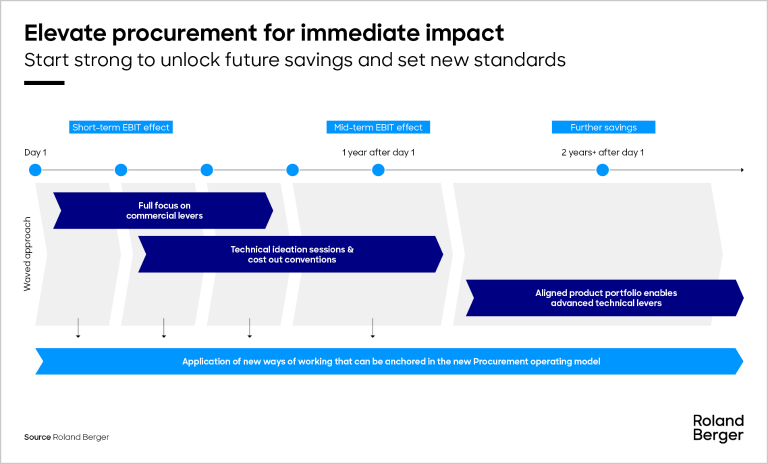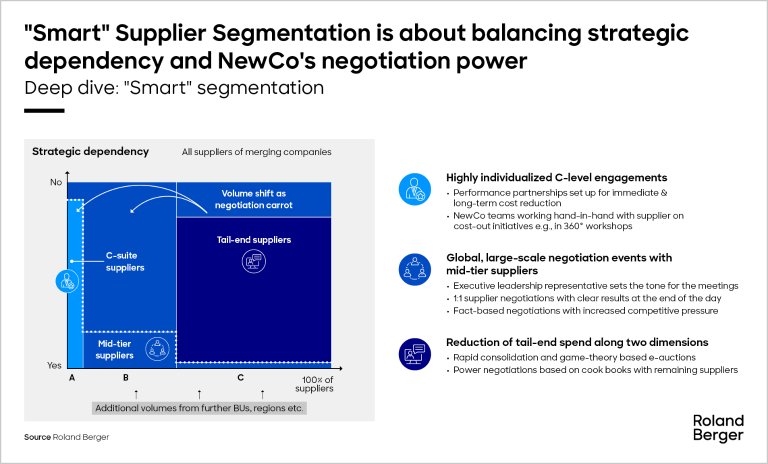Explore how Generative AI is revolutionizing procurement by addressing business complexities, compliance, rising costs, and market instability for a strategic advantage.


Unlocking procurement power in post-merger integration situations
By Oliver Knapp and Michael Jonas
Often underestimated, procurement can be a hidden value accelerator following a merger
In mergers and acquisitions, speed and synergy are everything. As global deal volumes surge — with an estimated CAGR of 70% over the last two years — companies are under increasing pressure to deliver value quickly. Yet, while finance and operations often take center stage in post-merger integration (PMI), one function remains consistently underestimated: procurement.
In PMI, procurement becomes a strategic accelerator, capable of unlocking double-digit value, stabilizing operations, and shaping the competitiveness of the newly formed entity. Crucially, the window to act is narrow.

Procurement’s strategic moment
When two or more companies merge, procurement is one of the few functions that immediately benefits from scale. Spend volumes increase, creating instant opportunities for bundling, renegotiation, and supplier consolidation. The combined entity — the “NewCo” — becomes a more attractive partner for suppliers, boosting negotiation power and enabling rapid synergy capture.
In fact, up to one-third of total synergies in M&A can come from procurement, often realizable within the first 12 months. Roland Berger’s experience shows that 8-15% value potential is typical, depending on spend patterns, category structures, and company size.
But unlocking this value requires more than just contract harmonization and supplier negotiations; it demands strategic foresight, teaming across the NewCo organization, and full use of digital innovation.
Six key success factors for procurement in PMI
At Roland Berger, we’ve identified six critical success factors that consistently drive procurement performance in PMI :
- Supplier segmentation must be smart. Think strategic dependency, business criticality, and supplier maturity. Tailoring engagement formats to supplier profiles maximizes leverage and minimizes risk.
- NewCos must balance short-term wins with long-term value. Quick renegotiations are tempting, but they must not jeopardize technical levers, innovation potential, or strategic relationships in the long run.
- AI-powered negotiations are no longer optional. Tools like GenAI spend cube harmonizers and negotiation dossier writers can reduce preparation time by up to 80%, enabling fact-based, scalable negotiations that deliver results fast.
- Change must be activated early. Cross-functional teams need to be mobilized and motivated from day one. Integration fatigue is real, and early wins are critical to sustaining energy and engagement.
- Building a credible narrative is non-negotiable. Suppliers must hear one voice from the NewCo. A unified message is key to show the full power towards the supply base – with no room for discussions behind the curtains.
- A strong content PMO is essential. This central team provides the “drumbeat” — analytics at scale, coaching for negotiation teams, and hands-on support to maintain momentum and ensure consistency.
"In a world where 60-80% of deals fail to deliver expected value during PMI, procurement is much more than just a lever."
Getting the basics right: The power of segmentation and levers
Let’s start with segmentation, which begins with two questions: How critical is this supplier to NewCo’s continuity and competitiveness? And, How much leverage does scale give us? The answers create three clusters.
“C-suite suppliers”, often technology or capacity gatekeepers, require top-level engagement and a narrative that blends price with roadmap alignment. Here, levers extend beyond unit cost: should-cost analysis, design-to-value, and gain-share models anchor negotiations that protect innovation while extracting fair value.
The “mid-tier”, where most spend sits, is the engine for early synergies. These suppliers respond to structured competition: harmonized negotiation dossiers, multi-round bidding, and lotting strategies that exploit commonality without triggering qualification delays. Commercial levers dominate, inluding volume bundling, indexation resets, and payment-term alignment, but must be sequenced to avoid foreclosing later technical harmonization.
The “tail-end” is about simplification and consolidation. Thousands of low-impact suppliers consume disproportionate effort. By contrast, rapid consolidation, catalog harmonization, and e-auctions deliver both savings and process efficiency. Treating this as a program, not a series of tactical clean-ups, frees capacity for strategic work.
Lever selection is where discipline matters most. Quick wins, in the form of rebates, freight-term alignment, and bundled volumes, create early cash, but the real prize lies in long-term perspectives and technical levers: specification harmonization, platforming, and sourcing strategy redesign.
Commonality analysis determines where to apply which lever: identical parts from the same supplier call for price harmonization; interchangeable parts from different suppliers invite competition; divergent specifications solving the same function demand engineering-led redesign. Boundary conditions such as directed buys, tooling ownership, and regulatory approvals help define what is feasible and when.
How AI-powered tools improve negotiations
Digital tools play a pivotal role in PMI integration. Roland Berger’s suite of AI-powered solutions, from spend cube harmonizers to parametric cost models, enables procurement teams to move from fragmented data to negotiation-ready insights in days, not weeks.
As well as accelerate execution, these tools can also elevate the quality and outcome of negotiations with your suppliers.
Avoiding common pitfalls
Despite its potential, there are also numerous procurement-related risks in PMI. Delayed involvement leads to missed early wins, while fragmented supplier data hampers synergy realization. Overestimated targets erode credibility, and, without proper change management, resistance and churn can derail even the best-laid plans.
Avoiding these pitfalls requires early planning, cross-functional alignment, and a clear procurement integration strategy, ideally led by the CPO and supported by top management.
The key to unlocking PMI potential
Procurement is the hidden accelerator in post-merger integration. When activated early and strategically, it delivers rapid value, stabilizes operations, and positions the NewCo for long-term success.
In a world where 60-80% of deals fail to deliver expected value during PMI, procurement is much more than just a lever.
Don’t leave money on the table. Unlock the full potential of your merger through procurement.




_tile_teaser_w425x260.jpg?v=1043579)











